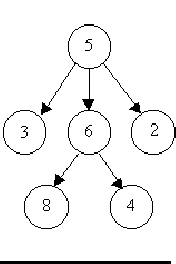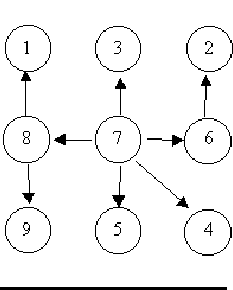水题(并查集+判断是否是树)(详细测试数据)
There is exactly one node, called the root, to which no directed edges point.
Every node except the root has exactly one edge pointing to it.
There is a unique sequence of directed edges from the root to each node.
For example, consider the illustrations below, in which nodes are represented by circles and edges are represented by lines with arrowheads. The first two of these are trees, but the last is not.



In this problem you will be given several descriptions of collections of nodes connected by directed edges. For each of these you are to determine if the collection satisfies the definition of a tree or not.
6 8 5 3 5 2 6 4 5 6 0 0
8 1 7 3 6 2 8 9 7 5 7 4 7 8 7 6 0 0
3 8 6 8 6 4 5 3 5 6 5 2 0 0
0 0
1 2 3 4 4 3 0 0
1 2 3 4 0 0
1 2 2 1 0 0
1 1 0 0
2 3 0 0
1 2 2 3 3 1 5 6 0 0
1 2 2 3 3 4 4 1 0 0
yes
yes
no
yes
no
no
no
no
yes
no
no
如果这些数据都对了的话差不多就过了
代码:
#include<stdio.h>
#include<map>
#include<string.h>
#include<queue>
using namespace std;
map<int,int> mp;
queue<int> v;
int lg;
int fz[100050],vt[100050];
int add(int b)
{
if(mp.count(b))//记录入度是否超过1
lg=0;
else
mp[b]=1;
return 0;
}
int find(int a)
{
if(fz[a]==a||fz[a]==-1)
return fz[a]=a;//因为一开始fz全赋值为-1,所以在这要赋为它自己
return fz[a]=fz[fz[a]];
}
int main()
{
int i,j,k;
j=0;
int a,b;
while(scanf("%d%d",&a,&b)!=EOF&&(a>=0||b>=0))
{
lg=1;
j++;
k=0;
mp.clear();//记得清空mp
memset(fz,-1,sizeof(fz));
memset(vt,0,sizeof(vt));
add(b);//计算入度
if(vt[a]==0)
v.push(a),vt[a]=1;//记录有哪些点,节省时间
if(vt[b]==0)
v.push(b),vt[b]=1;
int c,d;
c=find(a);
d=find(b);
if(c!=d);//将两个合并为一个集合
fz[c]=d;
if(a!=0||b!=0)//判断是否为空树
while(scanf("%d%d",&a,&b)!=EOF&&(a+b))
{
if(vt[a]==0)
v.push(a),vt[a]=1;
if(vt[b]==0)
v.push(b),vt[b]=1;
add(b);
int c,d;
c=find(a);
d=find(b);
if(c!=d);
fz[c]=d;
}
else
k=1;
int sum=0;
int cnt=0;
while(!v.empty())
{
int y=v.front();
v.pop();
//printf("w%d %d\n",y,fz[y]);
if(y==fz[y])
sum++;
if(!mp.count(y))//小心环,例1 2 2 1 0 0,如果没有这条语句则显示是树,而它不是
cnt++;
}
//printf("%d %d\n",lg,sum);
if(k==1)//判断是否是空树
printf("Case %d is a tree.\n",j);
else if(lg&&sum==1&&cnt==1)//判断是否是树
printf("Case %d is a tree.\n",j);
else
printf("Case %d is not a tree.\n",j);
}
return 0;
}



